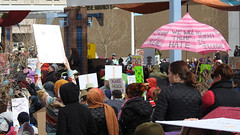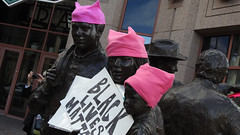The Story Behind the Backmasking of Beatles “Revolution 9”
“Revolution 9” is a recorded composition that appeared on The Beatles’ 1968 self-titled LP release (popularly known as “The White Album“). The sound collage, credited to Lennon/McCartney, was created primarily by John Lennon with assistance from George Harrison and Yoko Ono. Lennon said he was trying to paint a picture of a revolution using sound. The composition was influenced by the avant-garde style of Ono as well as the musique concrète works of composers such as Edgard Varese and Karlheinz Stockhausen.
The recording began as an extended ending to the album version of “Revolution“. Lennon then combined the unused coda with numerous overdubbed vocals, speech, sound effects, and short tape loops of speech and musical performances, some of which were reversed. These were further manipulated with echo, distortion, stereo panning, and fading. The loop of “number nine” featured in the recording fueled rumors about Paul McCartney’s death after it was reported that it sounded like “turn me on, dead man” when played backwards.
McCartney argued against including the track on The Beatles, and it was generally poorly received by both fans and critics. At over eight minutes, it is the longest track that The Beatles officially released.
The piece begins with a slow piano theme in B minor and a male voice repeating the words “number nine”, quickly panning across the stereo channels. The unidentified voice was found on an examination tape in the studio archives. Lennon recalled: “I just liked the way he said ‘number nine’ so I made a loop … it was like a joke, bringing number nine in it all the time …” Both the piano theme and the “number nine” loop recur many times during the piece, serving as a motif.
The unusual nature of “Revolution 9” engendered a wide range of opinions. Lewisohn summarized the public reaction upon its release: “… most listeners loathing it outright, the dedicated fans trying to understand it.” Music critics Robert Christgau and John Piccarella called it “an anti-masterpiece” and noted that, in effect, “for eight minutes of an album officially titled The Beatles, there were no Beatles.
Based on interviews and testimony, prosecutor Vincent Bugliosi asserted that Charles Manson believed that many songs on the album The Beatles contained references confirming his prediction of an impending apocalyptic race war, a scenario dubbed “Helter Skelter”. According to Gregg Jakobson, Manson mentioned “Revolution 9” more often than any of the other album tracks, and he interpreted it as a parallel of Chapter 9 of the Book of Revelation. Manson viewed the piece as a portrayal in sound of the coming black-white revolution. He misheard Lennon’s distorted screams of “Right!” within “Revolution 9” as a command to “Rise!
“Revolution 9” played a notable part in the “Paul is dead” rumor that spread in late 1969. The rumor grew until the publication of an interview with McCartney in the 7 November 1969 issue of Life magazine. In addition to rebutting the rumor itself, The Beatles insisted that they never planted clues in order to perpetrate a hoax about McCartney’s death. Although “turn me on, dead man” is an example of a coincidental phonetic reversal rather than an intentional backmasking, the rumor popularized the idea that backmasking could be used to conceal secret messages in music.






Revolution 9 is my absolute favorite Beatles song. I love the Beatles no matter what, I love the mixture of sounds and I fully support the reason they wrote the song.
LikeLike
Paul what happened? You scared me I’m crying
LikeLike